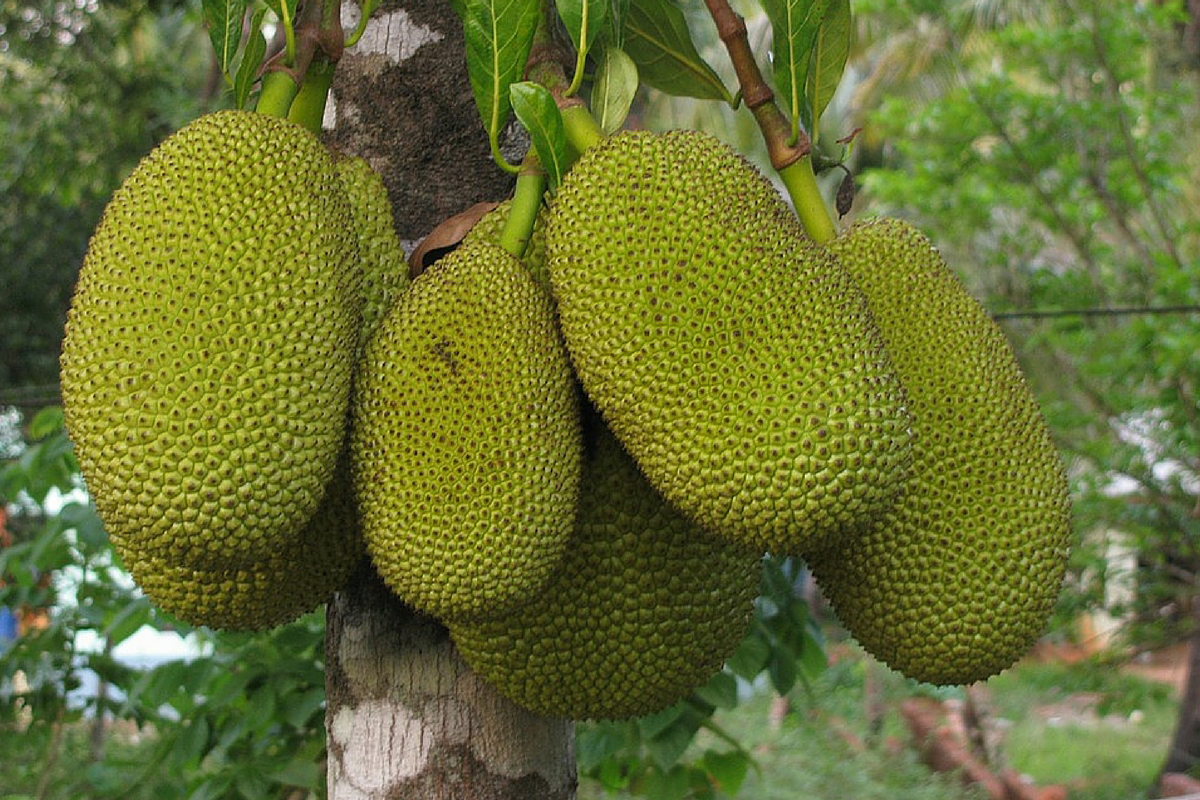
Botanical Classification
- Kingdom: Plantae
- Order: Rosales
- Family: Moraceae
- Genus: Artocarpus
- Species: A. heterophyllus
Distribution
- Jackfruit (Artocarpus heterophyllus) is a tropical evergreen tree belonging to the Moraceae family.
- Native to the Western Ghats of India.
- Cultivated in tropical and subtropical regions of Asia, Africa, and South America.
- Major producing countries: India, Bangladesh, Thailand, Sri Lanka, Indonesia, Philippines, and Brazil.
Economic Importance
- Nutritious fruit: Rich in vitamins A, C, potassium, and fiber.
- Timber: High-quality wood used for furniture, construction, and musical instruments.
- Industrial use: Jackfruit seeds used in flour, snacks, and biofuel production.
- Income generation: High demand in domestic and export markets.
Climate and Soil Requirements
Climate
- Grows well in tropical and subtropical regions.
- Requires a warm and humid climate with temperatures between 20-35°C.
- Prefers an annual rainfall of 1000-2000 mm.
- Cannot tolerate frost and waterlogging.
Soil
- Well-drained, deep, sandy loam to clay loam soil with rich organic matter.
- pH range 5.5 to 7.5.
- Prefers soil with good moisture retention but not prone to waterlogging.
- Avoid saline and alkaline soils.
Popular Varieties of Jackfruit in India
|
Variety |
Characteristics |
Yield (Fruits/Tree/Year) |
Yield (kg/Tree/Year) |
|
NS-1 |
Medium-sized, firm pulp, sweet taste |
100–150 |
200–250 |
|
P B R Jack |
Large fruit, soft flesh, high sugar content |
80–120 |
300–350 |
|
Swarnarekha |
High-yielding, golden yellow pulp |
120–180 |
250–300 |
|
Singapore Jack |
Small fruit, crispy pulp, good for chips |
150–200 |
200–250 |
|
Dang Rasimi |
Thai variety, high TSS (sweetness) |
100–130 |
250–300 |
|
Golden Nugget |
Small fruit, early maturity |
120–160 |
180–220 |
|
Black Gold |
Dark yellow pulp, high market value |
100–140 |
200–280 |
|
Panruti Jack |
Native to Tamil Nadu, high market demand |
80–120 |
250–300 |
|
Baripada Jack |
Found in Odisha, large-sized fruit |
90–140 |
300–350 |
Based on Region of Cultivation in India
- Kerala: Koozha, Varikka.
- Tamil Nadu: Panruti Jack, Vellore Jack.
- Karnataka: Swarna, Mankale.
- Odisha: Baripada Jack.
- Uttar Pradesh: Early Golden, Hazari Jack.
Propagation and Planting
Propagation Methods
- Seeds: Common but results in genetic variability.
- Vegetative Propagation:
- Grafting (Approach, Softwood, Veneer)
- Air-layering
- Budding (Patch or shield budding)
- Cuttings (Less common)
Planting Method
- Season: Best time for planting is June to August (monsoon season).
- Spacing: Traditional spacing 10m x 10m (100 trees/ha); high-density planting 5m x 5m (400 trees/ha).
- Pit size: 1m x 1m x 1m filled with farmyard manure (FYM), soil, and sand mixture.
- Planting depth: Same depth as in the nursery.
High-Density Planting
- Adopted to maximize yield per unit area.
- Spacing: 5m x 5m (400 trees/ha).
- Requires intensive pruning and training.
- Ensures better sunlight penetration and higher productivity.
Nutrient Management
|
Nutrient |
Age (Years) |
Quantity per tree per year |
|
Farmyard Manure (FYM) |
1-2 |
10-15 kg |
|
NPK (10:10:10) |
3-5 |
100-250 g |
|
NPK (10:10:10) |
6+ |
500-1000 g |
- Application schedule: Apply manure and fertilizers in two splits (pre-monsoon & post-monsoon).
- Micronutrients: Zinc (Zn), Boron (B) essential for fruit quality.
Irrigation and Water Management
- Young plants need regular watering (once a week in dry season).
- Mature trees require less frequent irrigation (every 15-20 days in summer).
- Drip irrigation is recommended for efficient water use.
- Avoid waterlogging, which can cause root rot.
Cultural Operations
Pruning and Training
- Remove water sprouts, diseased branches, and weak shoots.
- Allow 3-4 main branches to develop for proper canopy formation.
Weed Management
- Mulching with dry leaves, straw, or coconut husk reduces weed growth.
- Intercropping with legumes (cowpea, green gram) helps suppress weeds.
- Manual weeding every 2-3 months.
Flowering and Fruit Set
- Jackfruit trees start flowering after 3-5 years.
- Flowering occurs February to April, fruiting from June to August.
- Hand pollination can improve fruit set in commercial orchards.
- Fruit matures 90-150 days after pollination.
Pests and Diseases
Major Pests
|
Pest |
Symptoms |
Control Measures |
|
Jackfruit borer (Diaphania caesalis) |
Bores into fruits, causing rotting |
Spraying Neem oil (5%) or Bacillus thuringiensis |
|
Mealybugs |
White cottony masses on shoots and fruits |
Spraying Insecticidal soap or Neem oil |
|
Scale Insects |
Sucking pests causing yellowing of leaves |
Application of Horticultural mineral oil |
Major Diseases
|
Disease |
Symptoms |
Management |
|
Stem rot |
Bark cracking, yellowing leaves |
Bordeaux mixture (1%) or Copper fungicides |
|
Fruit rot |
Fungal infection, black lesions on fruit |
Carbendazim spray (0.1%) |
|
Powdery mildew |
White powdery coating on leaves |
Sulfur dusting or Neem extract spray |
Harvesting and Post-Harvest Management
Harvesting
- Fruits mature 90-150 days after flowering.
- Signs of maturity:
- Change in fruit color (green to yellowish-green).
- Hollow sound when tapped.
- Aroma starts developing.
- Spines become flattened.
- Harvest using sharp knife or sickle.
Post-Harvest Handling
- Remove latex by keeping the fruit inverted for a few hours.
- Store at 13-15°C to extend shelf life.
- Processing: Jackfruit can be used for chips, jam, nectar, and frozen pulp
Average Yield of Jackfruit
- Per Tree: 80–200 fruits per year (depending on variety and management).
- Per Acre: 8–10 tons per year (under optimal conditions).
- Commercial Plantation Yield: 10–20 tons per hectare.

